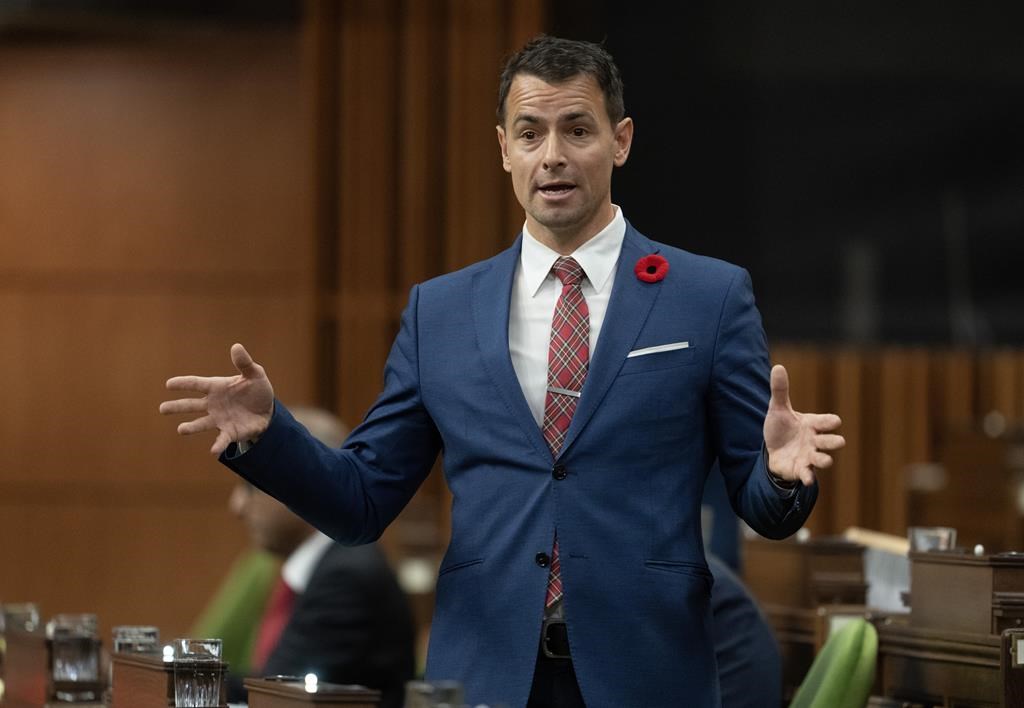The dispute between Ottawa and Alberta over environmental oversight spilled into a House of Commons committee meeting Tuesday when a Liberal member tried to pass a motion reprimanding the province’s energy regulator.

Adam van Koeverden’s motion read, in part, “that the (standing committee on environment) express its disappointment in the Alberta Energy Regulator and that the (regulator) has been deficient in protecting the environment.”
The motion didn’t come to a vote after a Conservative filibuster. Conservative Gerard Deltell argued the motion was outside the committee’s purview.
“We are not talking about federal jurisdiction,” he said. “If you want to run (for election) in Alberta, good luck.”
Van Koeverden– parliamentary secretary to Environment Minister Steven Guilbeault– said his call to audit oilsands tailings ponds, study their health impacts and increase monitoring came out of frustration with answers the committee received from Laurie Pushor, head of the Alberta Energy Regulator, over its response to two releases of wastewater from Imperial Oil’s Kearl oilsands mine.
In May 2022, tailings seepage at the oilsands mine north of Fort McMurray, Alta., was reported to First Nations and communities as discoloured water pooling on the surface. They received little information after that until February, when the regulator issued environmental protection orders against Imperial– and then only after 5.3 million litres of contaminated wastewater escaped from a holding pond.

Get daily National news
Pushor, making his second appearance before the committee, was repeatedly asked about evidence that has come to light since the releases that tailings are entering groundwater and may be seeping beyond the Kearl lease.
“The information I have indicates that there are very concerning trends in the monitoring results from outside the lease area,” said New Democrat Taylor Bachrach.
Bachrach also referred to reports by The Canadian Press that quoted documents showing the regulator knew tailings were seeping out long before they were spotted welling up to the surface.
“How long has this toxic tailings water been seeping into the environment?” he asked.
Pushor replied that he couldn’t respond because of the formal investigation the regulator has opened into the releases.
“I’m not able to get into specifics,” he said.
Environment Canada is also investigating the releases.
Pushor said Imperial has been required to install more than 100 monitoring and pumping wells in the area.
“There has been a definition of the plume,” he said. “We continue to see stable or declining incidence (of contaminants), but we want to continue to enhance our understanding of what is happening.”
Van Koeverden was not reassured by Pushor’s statement that seepage from tailings ponds is normal and anticipated, and kept on the lease site through monitoring and pumping wells.
“These disasters should be prevented, not allowed to seep into the environment.”
Documents filed with the regulator show that Kearl isn’t the only oilsands mine with a seeping tailings pond.
Suncor has reported that eight of its monitoring wells at its Fort Hills site have groundwater quality issues. Tailings have also been detected in wells at Syncrude’s Mildred Lake mine.
Seepage has not been detected off mine lease sites.
The committee’s criticism of the energy regulator comes after the provincial United Conservative Party government initiated a review of its operations. The job was given through a sole-source contract to a longtime oilpatch executive and conservative activist.
Alberta opposition members and a prominent First Nations chief have called for that review to be expanded and made public.
It also comes as Ottawa and the province spar over regulatory matters such as methane emissions and an emissions cap on the oilsands. Alberta maintains it has exclusive jurisdiction over those matters, while the federal government argues environmental issues are shared.
Van Koeverden, after the meeting, expressed frustration over what he called Conservative attempts to frame the Kearl releases as a communications issues.
“They’re acting as if it’s just a PR problem,” he said.





Comments